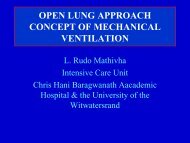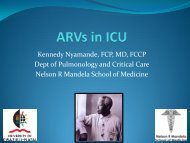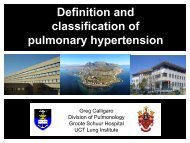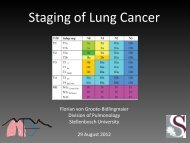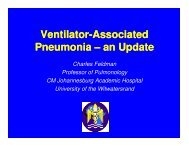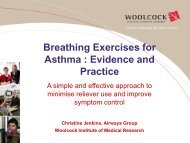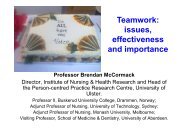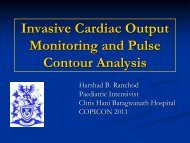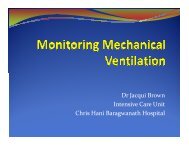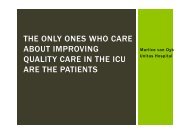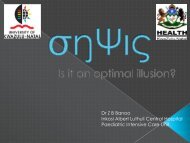Andrew Argent Criteria for admission and refusal to PICU
Andrew Argent Criteria for admission and refusal to PICU
Andrew Argent Criteria for admission and refusal to PICU
You also want an ePaper? Increase the reach of your titles
YUMPU automatically turns print PDFs into web optimized ePapers that Google loves.
<strong>Criteria</strong> <strong>for</strong> <strong>admission</strong> <strong>and</strong><strong>refusal</strong> <strong>for</strong> <strong>PICU</strong><strong>Andrew</strong> C <strong>Argent</strong>Red Cross War Memorial Children’s Hospital <strong>and</strong>University of Cape Town
introduction• triage– primarily about allocation of resources– prioritization of the sickest• but sometimes may need <strong>to</strong> limit <strong>admission</strong> of thosewho are the sickest, but have the highest risk of dyingdespite the allocation of resources– prioritization of those most likely <strong>to</strong> benefit• elective procedure vs. emergency <strong>admission</strong>• overall context of health servicerationing is universalRudolf Klein, King's Fund BMJ 1998
L<strong>and</strong> MassChildrenworldmapper.com
HIVMortality1-4 yearsworldmapper.com
ChildrenPublic HealthExpenditureworldmapper.com
<strong>PICU</strong> at the RCWMCH• 300 bed children’s hospital• 20 (18-22) bed multidisciplinary <strong>PICU</strong>• 1100-1300 patients per annum– 700+ paediatric emergencies– 210 elective cardiac surgical cases– 200 elective surgical cases– 30 – 40 major burns– 30 - 40 Road traffic accidents (mostly head injury)
<strong>PICU</strong> at the RCWMCH – staffing• medical staff:– 4 consultants (3 <strong>for</strong> last year)– 2-4 fellows (2 funded posts)– 4 registrars <strong>and</strong> 2 medical officers (outside help <strong>for</strong>after hours)• nursing staff– approximately 60 registered nurses (20 with ICUtraining)– approximately 40 enrolled <strong>and</strong> auxiliary nurses
the challenge• not enough beds <strong>to</strong> admit all referred patients• maintaining a patient throughput that– meets the patient needs– allows an “adequate” st<strong>and</strong>ard of care withreasonable risks of adverse events– does not burn out the staff• optimize the utilization of resources <strong>to</strong> provideoptimal benefit
the good we aim <strong>to</strong> achieve• moni<strong>to</strong>ring of high risk patients <strong>to</strong> rapidly identify lifethreateningproblems– early intervention <strong>to</strong> prevent major complications• provision of life support therapy– ventilation– circula<strong>to</strong>ry support– other organ system support• provision of definitive diagnosis <strong>and</strong> therapy – allow majorsurgical intervention• return children <strong>to</strong> healthwhere does palliative care fit in?
…. a fundamental concept is that the aim of intensive supports isnot <strong>to</strong> treat symp<strong>to</strong>ms or <strong>to</strong> cure diseases, but <strong>to</strong> care <strong>for</strong> thepatient. The object (better, the subject) of the curing/caringprocess is always the patient. The intensive supports should beused as long as they are useful <strong>to</strong> the patient, according <strong>to</strong> her/hiswishes <strong>and</strong> project of life.The way things are done can be at least as important as thespecific content of every action. In particular, the decisionshould be clear, known, <strong>and</strong> shared by all the involved subjects,
can we do harm?• is it possible that we prolong or create suffering?– <strong>for</strong> the child– <strong>for</strong> the family• do we really underst<strong>and</strong> the long-term impact of the <strong>PICU</strong>stay?• adverse events in the <strong>PICU</strong>• what is the impact of the <strong>PICU</strong> on the rest of the institution?• what about the staff who work in intensive care?
use of resourcesDiscipline Count % Averagedurationof stay% beddaysMortalityPaediatrics 411 54.44 5.4 66.61 15.6Cardiac 107 14.17 3.92 12.59 3.74Thoracic 16 2.12 3.8 1.82 0Abdominalsurgery 63 8.34 1.96 3.71 1.5Neurosurgery 26 3.44 3.11 2.43 0Other surgeryincludingaccidents<strong>and</strong> burns 65 8.61 4.7 9.17 13.8
the response …• development of a policy• dissemination of the policy throughout theinstitution <strong>and</strong> through the health system• ongoing moni<strong>to</strong>ring• feedback <strong>and</strong> response
agreement on the principles• is this in the child’s best interest– who makes that decision– we need the best available in<strong>for</strong>mation• there has <strong>to</strong> be equity of access– geographical– discipline– emergency vs elective• there has <strong>to</strong> be a sense of fairness– <strong>for</strong> patients– within the health system
who should be admitted?anyone who can benefit fromwhat we have <strong>to</strong> offer
who should not be admitted• care deemed futile– <strong>admission</strong> <strong>to</strong> <strong>PICU</strong> will not affect final outcome• underlying lethal condition– even if they survive this <strong>admission</strong> <strong>to</strong> <strong>PICU</strong>, they will die sooner ratherthan later• currently poor outcome– in our h<strong>and</strong>s these patients do badly(this is problematic in the sense of developing new therapy <strong>and</strong> approach<strong>to</strong> management)• the child who is “<strong>to</strong>o well”concerns regarding the development of alternative care plans
when should life-sustaining therapyNOT be offered?• These situations include– the brain dead child– the child in permanent vegetative state– the “no chance” situation– the “no purpose ” situation– the “unbearable ” situationWithholding Or Withdrawing Life Sustaining Treatment inChildren. A Framework <strong>for</strong> Practice. Royal College ofPaediatrics <strong>and</strong> Child Health. 2004
underlying lethal condition …• this is not a static concept– HIV• initial• current• what is the data?• what do we aim <strong>to</strong> do– palliation is a perfectly reasonable reason <strong>for</strong><strong>admission</strong>
20022003(16 m)2006 2007 2011Exposed 136 96 79 63 42Infected 118 68 43 34 60ICU survival(% infected)73 75 74 70Hospital survival(% infected)Alive <strong>and</strong> at Followup or transferred(%)Lost <strong>to</strong> follow up(%)46 51 51 ± 6514 19 5532 5where <strong>to</strong> now?Sean Barnabus
currently poor outcome• in our h<strong>and</strong>s these patients do really badly– kwashiorkior with severe sepsis– AVSD with pulmonary stenosis• do we have the data?– or how will we collect it?• these patients are not always that clearly defined• are we simply maintaining the status quo – with nochance of improvement
the child who is <strong>to</strong>o well• where is the margin?• is there a margin of safety• do we underst<strong>and</strong> the risks in particularpatients <strong>and</strong> in particular conditionsthe closer we operate <strong>to</strong> the marginsthe higher the probability ofcatastrophic error
the review
issues on implementation• dissemination of in<strong>for</strong>mation on ongoing basis• consistency of application of policy• feedback (or lack of … from clinicians)• concerns about quality of palliative care• failure <strong>to</strong> address resource issues– attempts have been made but ….recurrent pressures <strong>to</strong> “ring-fence” beds
patients referred <strong>to</strong> <strong>PICU</strong>• all patients referred <strong>to</strong> <strong>PICU</strong> <strong>for</strong> possible<strong>admission</strong> over a 6 month period• reviewed both decision on <strong>admission</strong> <strong>and</strong>reason <strong>for</strong> that decisionn %accepted 618 80.9refused 146 19.1<strong>to</strong>tal 764Ahrens et al, unpublished data
easons <strong>for</strong> <strong>refusal</strong>sn %no beds 95 65.1futility 20 13.7<strong>to</strong>o ill 5 3.4not ill enough 26 17.8<strong>to</strong>tal 146Ahrens et al, unpublished data
what happened <strong>to</strong> the patients?Acceptedpatients% Futile /AIDS%Not illenough%Nobedsnobeds%2 10 18 69.23 62 76.5Discharged 420 69.8p
admittedrefused
data with PIM2Year Admissions Deaths MortalityPIM2Risk(ave)PIM2 Risk(median)SMR2006 1074 114 0.106 0.138 0.058 0.762007 1067 131 0.122 0.1388 0.053 0.882008 1330 139 0.104 0.129 0.059 0.812009 1141 141 0.124 0.131 0.742010 1265 115 0.090 0.132 0.056 0.68(2011) 943 79 0.083 0.135 0.052 0.62
<strong>PICU</strong> data on treatment of septic shockMedian time (minutes )from RCWMCHpresentation <strong>to</strong>ACCM/APLS guidelines(minutes)1 st fluid bolus 52 5intubation 135 15starting inotropes 217 15<strong>PICU</strong> <strong>admission</strong> 240 60Median time (minutes)from RCWMCH <strong>PICU</strong><strong>admission</strong> <strong>to</strong>1 st fluid bolus 15intubation 301 st dosehydrocortisone1140 60Rossouw et al, unpublished data, 2011
what happens <strong>to</strong> our patients?• ventila<strong>to</strong>r associated pneumoniaMorrow et al, Pediatr Crit Care Med, 2011Morrow & <strong>Argent</strong>, J Paediatr Child Health, 2009Morrow et al, J Paediatr Child Health, 2006Figaji et al, Childs Nerv Syst, 2009• other studies including nosocomial infection,fluid, cardiac patientsHatherill et al, Intensive Care Med, 2007Hatherill et al, Arch Dis Child, 2005
A 4 RDaniels <strong>and</strong> Sabin, Health Affairs, 1998Martin <strong>and</strong> Singer, Health Care Analysis, 2003
Duty <strong>to</strong> provide careEquityTrustTransparencyConsistencyInclusivenessResponsivenessAccountabilityThe process was an attempt <strong>to</strong> provide care <strong>to</strong> as many children as possible,within the resources available. In South African law the principle has beenestablished that the health care services cannot provide all services <strong>to</strong> allpeople (Subramoney case)No particular groups were excluded. In fact attempts were made <strong>to</strong> improveaccess <strong>to</strong> care <strong>for</strong> children from outside the major teaching hospitals.Development of trust in the system is an ongoing concern <strong>and</strong> will have <strong>to</strong> bereviewed <strong>and</strong> assessedThe process was open <strong>to</strong> comment, <strong>and</strong> was made public <strong>to</strong> clinicians <strong>and</strong>managers within the health system. It was not transparent <strong>to</strong> the generalpublic, or <strong>to</strong> specific groups of people who were potentially (or actually)affected by the process. Where possible the rationale behind specificexclusions was provided in the documentationImplementation of a specific policy improved overall consistency, butindividual consultants were aware of some variability in their implementationof the policyThe process was focused primarily on health professionals, <strong>and</strong> there was notadequate involvement of other stakeholdersThere were mechanisms within the system <strong>to</strong> respond <strong>to</strong> changes incircumstances, <strong>and</strong> there were mechanisms established <strong>to</strong> appeal againstspecific decisions.The clinicians whose patients were affected by the process had everyopportunity <strong>to</strong> appeal against decisions. In reality this happened very rarely.Managers <strong>and</strong> administra<strong>to</strong>rs were given details of the implications of theresources available <strong>and</strong> the attempts <strong>to</strong> use those resources appropriately.
<strong>and</strong> the staff …
conclusions• it is essential <strong>to</strong> optimize utilization of <strong>PICU</strong>resources– we have <strong>to</strong> be accountable <strong>for</strong> the resources that weuse• the A4R process may be a useful process– clarify <strong>for</strong> ourselves <strong>and</strong> <strong>for</strong> others what it is that wedo <strong>and</strong> why• need <strong>to</strong> balance the processes <strong>for</strong> control ofpolicy <strong>and</strong> implementation



